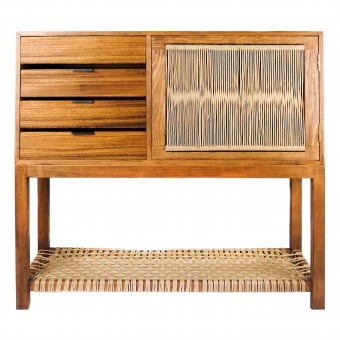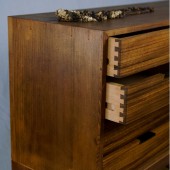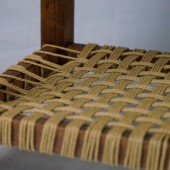Pohihi Entry Console by JOHI Furniture & Design |
Home > Winners > #89072 |
 |
|
||||
| DESIGN DETAILS | |||||
| DESIGN NAME: Pohihi PRIMARY FUNCTION: Entry Console INSPIRATION: Designed to tuck away bits and bobs while jointly displaying household favorites. We strove to highlight weaving, as it is an important technique used in my family's cultures, Arab and Hawaiian. As modern homes tend to get cluttered quickly, it was important to create a clean aesthetic that could l provide ample storage. Together, the wood and laced danish cord are intended to bring a warm modern feel to the home. UNIQUE PROPERTIES / PROJECT DESCRIPTION: Monkeypod drawer fronts & handwoven laced danish cord stand out as highlights of this piece, framed with a stained beech body. The drawers are completed with solid beech, sliding naturally on wooden tracks. The danish cord cabinet door gives this piece a unique, clean, organic touch. Open the cabinet door to find a spacious interior with shelf. With an easy push the magnetic fittings will secure it closed. Mirroring the woven door, a low shelf allows a gorgeous touch, functional and decorative. OPERATION / FLOW / INTERACTION: The handwoven Danish cord of the cabinet door acts both as artistic visual interest and a type of handle, as no distinct handle is in the design. The drawer handles are similarly low profile to let the clean lines of the overall design shine. PROJECT DURATION AND LOCATION: Location: Haliimaile, Maui, Hawaii, USA Year: 2019 FITS BEST INTO CATEGORY: Furniture Design |
PRODUCTION / REALIZATION TECHNOLOGY: Materials-wise, we needed to design around Hawaii's fluctuating climate, throughout the year moving from from humid to dry, hot to cold. For this reason, we chose to make the frame in dimensionally stable hardwood plywood and use traditional wood joinery that accounts for wood movement. You'll find more about our approach to weaving and reason for weaving with laced danish cord in the Research section. SPECIFICATIONS / TECHNICAL PROPERTIES: W 394mm x L 1156mm x H 1067mm TAGS: furniture, home, joinery, weaving, residential, interior, storage, modern, living RESEARCH ABSTRACT: We challenged ourselves to design around commonalities in Arab and Hawaiian cultural practices. We looked to our personal experiences from youth to adulthood as well as cultural readings and contemporary practice in both areas. Rather than focusing on visual pattern, we were drawn to the process of weaving. In the Arab world, Sadu (السدو) is the tradition of geometric embroidery for furnishings, rugs and saddles. This practice is historically carried out by the women of Bedouin communities, and it offers a chance to gather and share news and stories. As the world changes, this tradition is being left behind and is now considered a UNESCO Cultural Heritage Tradition in need of safeguarding. The same may be said of needing to safeguard knowledge here in Hawai'i of making and using cordage. Within Polynesian voyaging, fishing, and land cultivation culture, there was always great need to create strong durable kaula (cord/rope) from available natural resources. The plants often used include olona, pulu niu (coconut husk fiber) & hau (sea hibiscus). After gathering and crafting certain sizes and lengths of cordage, it could be used for canoe lashings, carrying handles or net bags, slings, sandals, a sewing material, and more. In reviewing weaving materials, we settled on weaving with laced Danish cord, a paper base product that began gaining popularity for use in furniture after WWII. Most cords feature a 3-ply construction, where paper is twisted together to produce a very strong laced cord. While it can be a little tricky to work with at times, knotting up on itself and untwisting, the cord is a perfect material choice for stressed applications and longevity in furniture. Experimenting with different weaving styles, we ultimately found the design needed variation between a less complex weave and one with more density to create a stronger visual dynamic. CHALLENGE: One of the most challenging aspects of designing a piece with multicultural intent is leaving flexibility for future clients or customers to impart their own style and interpretation on it. There's also much more to share from a cultural and locale perspective than what is stereotypical. There is more to island style than white washing wood; more to Hawaiian design than kapa motifs. There is more to Arab art than calligraphy and geometric pattern. Our goal was to design a contemporary piece that represented a common ground of our cultures and felt true to ourselves. ADDED DATE: 2019-06-30 19:18:24 TEAM MEMBERS (1) : Holly Badr-El-Din IMAGE CREDITS: Image #1 - #5: Photographer Raja Badr-El-Din, Pohihi Entry Console, 2019 PATENTS/COPYRIGHTS: Copyrights belong JOHI LLC, 2019 |
||||
| Visit the following page to learn more: http://www.hellojohi.com/ | |||||
| AWARD DETAILS | |
 |
Pohihi Entry Console by Johi Furniture & Design is Winner in Furniture Design Category, 2019 - 2020.· Read the interview with designer JOHI Furniture & Design for design Pohihi here.· Press Members: Login or Register to request an exclusive interview with JOHI Furniture & Design. · Click here to register inorder to view the profile and other works by JOHI Furniture & Design. |
| SOCIAL |
| + Add to Likes / Favorites | Send to My Email | Comment | Testimonials | View Press-Release | Press Kit |
Did you like Johi Furniture & Design's Furniture Design?
You will most likely enjoy other award winning furniture design as well.
Click here to view more Award Winning Furniture Design.








